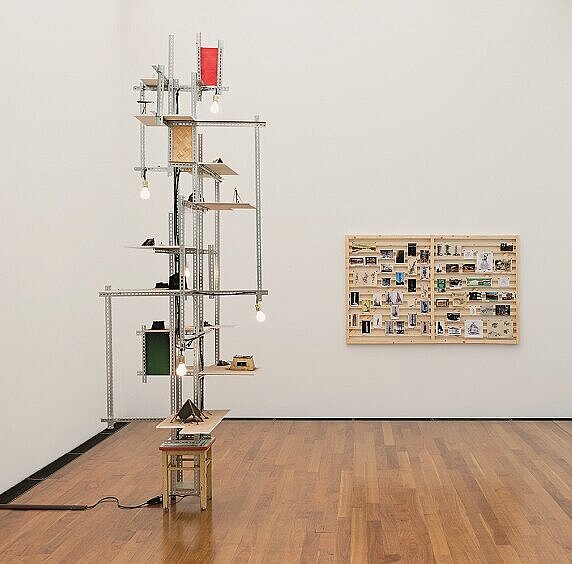Tamás Kaszás
Shanty Tower No. 2, 2014
Shelving profiles, plasterboard, wood, light bulbs, acrylic glass, photos, printed matter, wooden board
Tower 360 x 152 x 124 cm
Board 124 x 200 x 5 cm
© Artist
Photo: Franz Wamhof
The work of the Hungarian artist Tamás Kaszás presents a broad critical re flection on the impact of neo-liberal economics on society. Topics such as the ongoing destruction of the environment, the squandering of resources, the apparent hegemony of multinational concerns and the exploitative mechanisms of globalisation form the resonance chamber for his projects, which he sees as a catalyst for a process of social emancipation. Starting out with the house, the human abode, he raises the question in his model-like works of how an individual contending with a critical period in time can shape a self-determined life for him- or herself that squares with the criteria of sustainability and environ mental consideration.
Shanty Tower No. 2 consists of a construction that looms up with spirally-arranged platforms, bearing a highly disparate range of shabby, squalid miniature dwellings that have been cobbled together in a makeshift way. This tower lit up by naked light bulbs is accompanied by a pinboard bearing a selection of photographs and pictures from the artist’s archive. Everything in this piece has been made of cheap and readily available materials: prefabricated system profiles and MDF boards, for instance, objets trouvés from nature, litter and printed matter. The formal design of the tower is oriented on the one hand to Nicolas Schöffer’s Tours cybernétiques [Cybernetic Towers], on the other to the municipal “megastructures”, as they were called, designed in the fifties and sixties for urban development: according to the plans of Yona Friedman and Constant Nieuwenhuys, gigantic frameworks were to tend to the public utilities and be adjusted as required to the needs of modular plug-in housing areas, industrial estates and parks. Kaszás presents further references on a notice board, such as to utopian architectural designs from the twenties, improvised habitations, shelters done on a DIY basis, as well as traditional buildings from various cultures. The explicit aesthetic of functionalism in Shanty Tower No. 2 also possesses a romantic streak that comes across in the motif of “nocturnal” illumination and in the ruinous quality of scenes that are also set close to nature, and reflects a fundamental sense of liberty. Thus Kaszás’s works serve to convey practical knowledge: they are aimed at mobilising the creativity of the individual in the sense of reappropriating autonomous fields of action, while the concrete proposals in his œuvre anticipate life after the collapse of the biological and economic systems. (Hsiaosung Kok)
Tamás Kaszás
1976 born in Dunaújváros (HU)
Lives and works on Szentendrei Island (HU)


